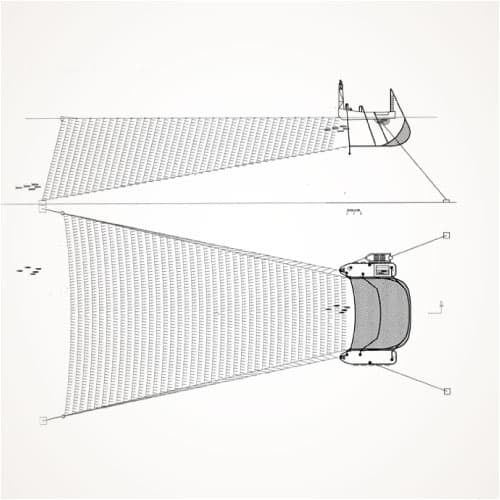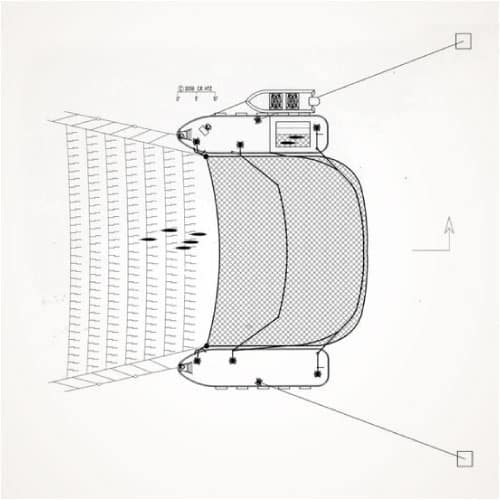To promote the respectful and responsible harvesting of wild salmon and to protect the environment for future generations of fish and people.
– LUMMI ISLAND WILD COOPERATIVE’S MISSION –
HISTORICAL SALMON FISHING METHOD
Wild Pacific salmon reefnet fishing is an historical Pacific Northwest fishing method- the oldest known salmon net fishery in the world. Once practiced throughout the Salish Sea by its many indigenous fishing communities, reefnet fishing now exists only off Lummi Island, three of the other San Juans Islands, and as of 2016 off of Cherry Point through a cooperative effort between Lummi Nation tribal members and Lummi Island Wild.
Using only the flood tide, salmon follow along an artificial reef and over a small net suspended between two stationary platforms. When spotters, standing on 20- foot towers, see a school of salmon swim over the net, it is raised and the live fish are rolled over the side of the platform at the waterline, so that no harm is done to them, and into a netted live well open to the flowing seawater. There they are allowed to rest, releasing any lactic acid that may have built up in their flesh.
It is then that any unwanted bycatch is released unharmed back into the sea. This is the major reason this fishery is so sustainable. The retained salmon are individually bled into an adjacent bleed well, and then into a tote filled with slush ice. The release of lactic acid and the lack of blood in the fish, results in the very highest quality salmon available in the world. The clean flavor is obvious when you taste it.
A passive fishing method, where electric motors powered by batteries work the net using no fossil fuels, reefnetting is considered one of the ten most sustainable fisheries in the world. Solar panels charge the batteries. Each reefnet gear is anchored to the sea floor in the same spot year after year, allowing for the smallest carbon footprint of any salmon fishery.
Because our Lummi Island Wild Reefnet fishery is so unique, much of the equipment is not commercially available. Our fishers have modified winches, solar panels and other equipment to fit their specific needs. Some winches even use motors off of WWII era planes!
How does Reefnetting work?
Using only the flood tide, salmon follow along an artificial reef and swim over a small net suspended between two stationary platforms. When spotters, standing on 20- foot towers, see a school of salmon swim over the net, it is raised and the live fish are rolled over the side of the platform at the waterline, so that no harm is done to them, and into a netted live well open to the flowing seawater. There they are allowed to rest, releasing any lactic acid that may have built up in their flesh.
Why is Reefnetting so sustainable?
The real sustainable advantage with reefnetting lies in its lack of by-catch mortality. From the live well, unwanted species are simply released, unharmed, back into their environment, allowing for careful selective fishing on mixed stocks. The abundant species can be retained, while species that are endangered can be released. This gives us an extremely high success rate for releasing non-targeted species unharmed. The reward, in this case, is seeing them swim away and knowing that they will survive to complete their age-old cycle of returning to their spawning grounds to ensure their species’ future.
How is it better for the environment?
A passive fishing method, where electric motors powered by batteries work the net using no fossil fuels, reefnetting is considered one of the ten most sustainable fisheries in the world. Solar panels charge the batteries. Each reefnet gear is anchored to the seafloor in the same spot year after year, allowing for the smallest carbon footprint of any salmon fishery.
The retained salmon are individually bled into an adjacent bleed well, and then into a tote filled with slush ice. The release of lactic acid and the lack of blood in the fish, results in the very highest quality salmon available in the world. The clean flavor is obvious when you taste it.



Reefnets stand out as the original and still the best in selective fishing.
– WASHINGTON STATE DEPARTMENT OF FISH & WILDLIFE –
Reefnetting and Lummi Island Wild…
Lummi Island Wild began as a way to bring these exceptional, reefnet-caught fish to market, eliminating the middlemen and giving them their due respect, instead of treating them as a commodity. Today, LIW Is the leader in showcasing Salish Sea Seafood. In addition to our own reefnet salmon, we use our own tenders to sail around the Salish Sea buying tribal halibut, Baker Lake sockeye, spot prawns, and all species of salmon. We are committed to reinforcing the truth that the more people realize what amazing seafood the Salish Sea produces, the more they will want to keep these waters as pristine as possible for future generations. Instead of calling a halibut a halibut, a salmon a salmon, or a crab a crab, we let you know where what we sell comes from. There is a huge difference, but unless you are allowed to taste that difference, you will never know why one piece of salmon or halibut tastes amazing, while the next is just “ok”. This applies to all of our seafood.

